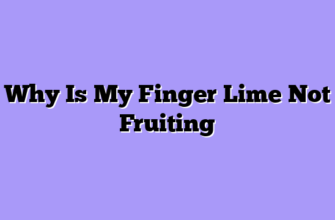I’ll never forget the eager anticipation I felt when I planted my first Australian finger lime saplings. Every morning, I’d walk out to check on them, half-expecting to see tiny caviar-like fruits dangling from the branches. My experienced mentor just laughed at my impatience.
“You’re in for a long wait, kid,” he said. “These aren’t tomatoes.”
Boy, was he right. Understanding the timeline for Citrus australasica to begin producing is absolutely crucial for anyone considering adding these remarkable native Australian citrus plants to their orchard – whether you’re a commercial grower like me or an enthusiastic home gardener.
The question “How long until my finger limes fruit?” ranks among the most common inquiries I receive from fellow farmers and backyard enthusiasts. The answer, frustratingly, isn’t simple. It’s like asking how long it takes to become a good guitar player – it depends on where you start, how you practice, and what “good” means to you. Let me share what I’ve learned through both success and failure about the fruiting timeline for these fascinating bushfood plants.
Starting Points Matter: Seedling vs. Grafted Trees
The most significant factor determining when you’ll taste your first citrus caviar pearls is whether you’re starting with seedling-grown or grafted plants. This distinction represents the difference between a sprint and a marathon, and it’s something I learned the expensive way.
My first venture into growing these microcitrus wonders involved purchasing inexpensive seedling plants from a well-meaning but misguided supplier. “They’re all the same once they grow up,” he assured me. What he didn’t mention – or perhaps didn’t know – was that seedling Citrus australasica can take anywhere from five to fifteen years to produce their first meaningful harvest. Yes, you read that correctly. Fifteen years.

Grafted finger limes, in contrast, operate on a completely different schedule. When you purchase a quality grafted plant from a reputable nursery, you’re essentially buying a mature plant’s productive capacity attached to vigorous rootstock. These cultivars typically begin flowering and setting fruit within two to four years of planting, depending on the size you purchase and your growing conditions.
Here’s how the timeline typically breaks down for grafted Australian native lime plants:
- Year One (Establishment): Your newly planted grafted sapling focuses entirely on root development and adapting to its new environment. Don’t expect any fruit, and actually, you should remove any flowers that appear to allow the plant to concentrate energy on establishing a strong foundation.
- Year Two (Early Development): The plant grows vigorously, developing its branching structure. You might see a few experimental flowers, particularly if you started with a larger specimen, but fruit set will be minimal or nonexistent. Again, I usually remove these early flowers.
- Year Three (First Meaningful Production): This is when things get exciting. Most grafted varieties will begin producing their first real crop. Don’t expect abundance – you might harvest anywhere from a handful to a pound or two of fruits – but you’ll finally taste the reward for your patience.
- Year Four and Beyond (Increasing Production): Production ramps up significantly. By year four, a healthy plant can yield three to five pounds of fruit annually, and mature specimens in years five through seven often produce six to ten pounds or more depending on variety and care.
The contrast between these approaches is stark enough that I created this comparison table for the workshops I teach:
| Starting Method | First Flowers | First Harvest | Significant Production | Mature Production | Cost Per Plant |
|---|---|---|---|---|---|
| Seedling | 5-8 years | 6-10 years | 10-15 years | 12-18 years | $10-$20 |
| Grafted (1-2 year) | 1-2 years | 2-3 years | 3-5 years | 5-7 years | $35-$60 |
| Grafted (3-4 year) | Immediate | 1-2 years | 2-3 years | 4-6 years | $60-$100 |
| Air-layered | 2-3 years | 2-4 years | 4-6 years | 6-9 years | $30-$50 |
The Hidden Variables That Accelerate or Delay Fruiting
Even with grafted caviar lime plants, the timeline isn’t set in stone. I’ve had plants from the same batch, planted on the same day, show dramatically different fruiting timelines. Understanding the factors that influence this variability has been crucial to optimizing my operation.
Climate and Growing Zone Impact
The subtropical origins of Citrus australasica mean these bushfood natives perform best in warm, frost-free environments. In my growing region, which experiences mild winters and warm summers, my finger limes follow the typical timeline I outlined above. However, I’ve corresponded with growers in cooler climates who report significantly delayed fruiting – sometimes adding one to three additional years before substantial production begins.
Temperature extremes during the juvenile growth phase can stress plants and delay their transition to reproductive maturity. I learned this when an unexpected late frost in spring damaged new growth on several of my young plants. Those particular specimens took an extra year to begin fruiting compared to their protected neighbors. Think of it like a teenager going through a major illness – their development doesn’t stop, but it definitely pauses and takes longer to reach certain milestones.
Nutrition and Soil Conditions
The soil chemistry and nutrient availability in your planting site dramatically influence how quickly these native lime plants reach productive maturity. I’ve run side-by-side trials comparing plants in optimized versus marginal conditions, and the results are striking.
My control group received premium care: acidic soil maintained between pH 5.5-6.5, regular applications of slow-release fertilizer formulated for citrus, generous organic mulch, and quarterly micronutrient supplements. These pampered plants produced their first significant harvest in year three like clockwork.
The comparison group went into slightly alkaline soil (pH 7.2) with minimal amendments and inconsistent fertilization. Despite being the same age and variety, these plants took an additional eighteen months to reach comparable production levels. Some still lag behind their well-fed cousins in overall productivity.
Here’s what I’ve found makes the biggest difference in accelerating your microcitrus plants toward fruiting:
- Maintaining proper soil acidity through sulfur amendments and acidic mulches like pine needles
- Providing consistent moisture without waterlogging – drip irrigation works beautifully
- Applying balanced citrus fertilizer every six to eight weeks during the growing season
- Ensuring adequate magnesium, iron, and zinc through foliar sprays or soil applications
- Mulching heavily to maintain soil temperature and moisture consistency
- Protecting young plants from temperature extremes with shade cloth or frost protection
Container Growing vs. In-Ground Planting
I’ve experimented extensively with growing these Australian finger limes in containers, particularly for customers wanting to cultivate them in cooler climates where they can be moved indoors for winter. The fruiting timeline for container-grown plants tends to extend by roughly 25-40% compared to in-ground specimens.
A grafted Citrus australasica that would fruit in year three when planted in the ground might take four to five years in a container. This delay relates to several factors: restricted root development, more frequent environmental stress from inconsistent watering, and the challenges of maintaining optimal nutrition in limited soil volume.
That said, container growing offers the advantage of controlled conditions, which can partially offset these drawbacks. I have several container-grown specimens that, once they began fruiting, have produced consistently because I can protect them from weather extremes and pest pressures more easily than field-planted trees.
Variety-Specific Timelines: Not All Cultivars Are Created Equal
Through maintaining a diverse collection of Citrus australasica varieties, I’ve observed that different cultivars reach productive maturity at somewhat different rates. While the variation isn’t enormous – we’re talking months rather than years – it’s worth considering when planning your planting.
Judy’s Everbearing lives up to its name by not only producing nearly year-round once mature but also by reaching that productive stage relatively quickly. In my experience, this variety often produces its first decent crop in late year two or early year three, making it one of the faster cultivars to reward your patience.
Crimson Tide, with its spectacular ruby-red vesicles, tends toward the slower end of the spectrum. I’ve found this variety typically takes a solid three to four years before producing meaningful quantities, even with optimal care. However, once it hits its stride, the production is excellent and the premium prices these fruits command make the wait worthwhile.
The Alstonville variety sits somewhere in the middle, generally fruiting well by year three and ramping up to good production by year four. Rainforest Pearl follows a similar pattern, making both solid choices for growers wanting relatively predictable timelines.
Real-World Expectations: What “Production” Actually Means
Let’s talk honestly about what you can expect when your caviar lime plants finally begin fruiting. This matters because “producing fruit” and “producing economically viable quantities” are two very different things, and managing expectations prevents disappointment.
When I tell people their grafted plant will fruit in year three, many imagine harvesting basketfuls of these precious citrus pearls. The reality is more modest. That first productive season, you might harvest anywhere from fifteen to forty fruits from a single plant – roughly a quarter to one pound depending on fruit size and variety. For a home gardener, that’s actually pretty exciting. For someone like me trying to supply restaurants, it’s barely enough to tease customers with samples.
Year four typically doubles or triples that output. By year five, I’m usually seeing four to six pounds per plant, and mature specimens in years six through eight can produce eight to twelve pounds annually under ideal conditions. I have a few exceptional plants that have yielded fifteen pounds in a single season, but that’s definitely not the norm.
To put this in perspective, compare it to standard citrus. A mature Valencia orange tree in my orchard might produce 200-400 pounds of fruit annually. My finger limes, even at peak maturity, produce a fraction of that weight. However, when I’m selling oranges for $1.50 per pound wholesale and finger limes for $35-45 per pound, suddenly those modest yields look quite attractive from a revenue perspective.
Here’s a realistic production timeline based on my records across multiple varieties:
| Plant Age | Average Fruits Per Plant | Approximate Weight | Wholesale Revenue (at $40/lb) |
|---|---|---|---|
| Year 1-2 | 0-5 | 0-0.1 lbs | $0-$4 |
| Year 3 | 15-40 | 0.3-1 lb | $12-$40 |
| Year 4 | 40-80 | 1-2 lbs | $40-$80 |
| Year 5 | 80-150 | 2-4 lbs | $80-$160 |
| Year 6-7 | 150-250 | 4-7 lbs | $160-$280 |
| Year 8+ | 200-400+ | 6-12+ lbs | $240-$480+ |
Strategies to Maximize Early Production
While you can’t completely override the biological timeline of Citrus australasica, there are definitely strategies to optimize early fruiting and maximize production once it begins. I’ve refined these approaches through considerable trial and error.
Proper Pruning Practices
Many novice growers make the mistake of over-pruning young finger lime plants, inadvertently delaying fruiting. These Australian native limes fruit on previous season’s growth, so aggressive pruning removes potential fruiting sites. I learned to be patient with shaping, doing only minimal corrective pruning in the first three years. Once plants begin fruiting, I prune strategically after harvest to maintain productive structure without sacrificing the next season’s crop.
Stress Management Through Critical Periods
Think of your young caviar lime plants like athletes training for a big event – you need to push them enough to grow stronger, but not so hard that they break down. During the transition period when plants are preparing to fruit (typically late in year two and throughout year three), protecting them from major stresses is crucial.
I’ve noticed that plants experiencing severe drought stress, pest infestations, or nutrient deficiencies during this critical window often delay fruiting by six months to a year. My approach involves extra vigilance during this phase: more frequent irrigation monitoring, aggressive pest scouting, and consistent fertilization schedules.
Strategic Flower and Fruit Thinning
This might seem counterintuitive, but removing excess flowers and fruits during early production actually enhances long-term productivity. When my plants produce their first blooms in years two or three, I often remove 50-75% of them, leaving just enough to get a small harvest while preventing the plant from exhausting itself.
It’s like asking a marathon runner to sprint – sure, they might be able to do it once, but it’ll compromise their training. By limiting early fruit set, you allow the plant to continue building the structural foundation needed for heavy production in subsequent years.
The Bottom Line: Patience Pays Dividends
So, returning to our original question: How long do finger limes take to fruit? If you’re planting quality grafted Citrus australasica specimens and providing decent care, expect your first taste around year three, with economically significant production beginning in years four through five. Choose seedlings, and you’re looking at potentially a decade or more of waiting.
Is that patience worth it? Standing in my orchard on a crisp autumn morning, harvesting pounds of these remarkable citrus pearls that will command premium prices at market, I can definitively say yes. But I won’t lie to you – those first few years test your resolve. You’ll second-guess your investment. You’ll wonder if you should have planted something more conventional. You’ll walk past those stubbornly flowerless bushes and sigh.
Then one spring morning, you’ll spot the first delicate white blooms dotting your branches, releasing their subtle citrus perfume into the air. Those flowers will transform into tiny green fruits that gradually swell and develop their characteristic cylindrical shape. And finally, months later, you’ll harvest your first ripe Australian finger limes, cut one open, and watch those jewel-like vesicles tumble onto your palm.
That moment makes every day of waiting worthwhile. Trust me on this one – I’ve been there, and I’d do it all over again in a heartbeat. Just maybe not with seedlings this time.








